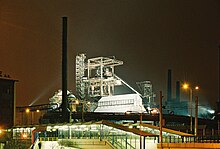| Katowice-Ostrava metropolitan area
aglomeracja katowicko-ostrawska katovicko-ostravská aglomerace | |
|---|---|
 | |
 | |
| Coordinates: 50°05′N 18°45′E / 50.083°N 18.750°E / 50.083; 18.750 | |
| Country | Poland, Czech Republic |
| Region | Silesian Voivodeship (Poland), Moravian-Silesian Region (Czech Republic) |
| Largest cities | Ostrava Katowice Sosnowiec Gliwice Zabrze Bielsko-Biała Bytom |
| Area | |
| • Metro | 5,400 km (2,100 sq mi) |
| Population | |
| • Metro | 5,008,000 |
| • Metro density | 930/km (2,400/sq mi) |
| GDP | |
| • Metro | €75.0 billion (2021) |
| Time zone | UTC+1 (CET) |

The Katowice-Ostrava metropolitan area (also known as Upper Silesian-Moravian metropolitan area or Upper Silesian urban-industrial agglomeration) is a polycentric metropolitan area in southern Poland and northeastern Czech Republic, centered on the cities of Katowice and Ostrava, and has around 5 million inhabitants. Geographically, it is located mainly in Upper Silesia, with small parts of the area also in the historical regions of Moravia and Lesser Poland. Administratively, it is located in the three administrative units (NUTS-2 class): mainly Silesian Voivodeship and a small western part of Lesser Poland Voivodeship in Poland, and also a small eastern part of Moravian-Silesian Region in the Czech Republic.
The metropolitan area lies within the Upper Silesian Coal Basin. The Upper Silesian metropolitan area (5.3 million people), together with nearby Kraków metropolitan area (1.3 million people) and Częstochowa metropolitan area (0.4 million people), create a greater Kraków-Katowice-Ostrava metropolitan region [Wikidata] covering 7 million people.
Demographics
Upper Silesian metropolitan area has a population of 5,294,000 (2002), with 4,311,000 (81.43%) in Poland (the Upper Silesian polycentric metropolitan area) and 982,000 (18.57%) in the Czech Republic (Ostrava Functional Urban Area). According to Polish Scientific Publishers (PWN) area is 5,400 km², with 4,500 km² (83.33%) in Poland and 900 km² (16.67%) in the Czech Republic. According to the Brookings Institution, area has a population of 5,008,000 (2015).
The area consists of several Functional Urban Areas (FUA), each of which is defined as a core Morphological Urban Area (MUA) based on population density plus the surrounding labour pool, i.e. a metropolitan area. This area contains the following FUAs:
- Katowice FUA: 3,029,000; within Upper Silesian Industrial Region
- Ostrava-Cieszyn FUA: 1,046,000; within Ostrava-Karviná coal basin [Wikidata]
- Bielsko-Biała FUA: 584,000; within Bielsko Industrial Region
- Rybnik FUA and Racibórz FUA: 634,000 (526,000 + 109,000); within Rybnik Coal Area
Economy

Historically, most of the area was characterized by heavy industry since the age of industrialisation in the late 19th and early 20th century. In addition to coal, Upper Silesia also contains a number of other minable resources (methane, cadmium, lead, silver and zinc). About 70 billion tons of coal resources are available up to a depth of 1000 meters and the conditions for extraction are good.
Contrary to most other European cross-border polycentric metropolitan regions, Katowice-Ostrava has no established cross-border cooperation project, structure, or institution of metropolitan ambition.
Transport
Air transport
Two international airports – Katowice Airport and Leoš Janáček Airport Ostrava – serve the area.
Rail transport
High-speed rail link between Katowice and Ostrava is scheduled to be completed by the year 2030. It will cut down the travel time between the two cities to 30-35 minutes.
Regional trains are operated by Koleje Śląskie, most importantly serving Katowice, Rybnik, Racibórz, Bielsko-Biała, and Cieszyn in Poland, and the railway junction station in Bohumín near Ostrava in Czechia.
Road transport
Polish A1 and Czech D1 motorways connect the urban areas of Katowice, Rybnik and Ostrava. Bielsko-Biała is linked with Cieszyn/Český Těšín and Frýdek-Místek by the Polish Expressway S52 and Czech D48 motorway, while connection to Katowice urban area via Expressway S1 is in construction.
Notes
ESPON used in "ESPON project 1.4.3" two almost identical names: Upper Silesian-Moravian metropolitan area and Silesian-Moravian polycentric metropolitan area.
See also
References
- ^ Brookings Institution Redefining global cities: The seven types of global metro economies (2016), p. 24.
- "Gross domestic product (GDP) at current market prices by metropolitan regions". www.ec.europa.eu. Retrieved 12 December 2023.
- Brookings Institution Redefining global cities: The seven types of global metro economies (2016), p. 16.
- European Spatial Planning Observation Network (ESPON) "Metroborder: Cross-border Polycentric Metropolitan Regions" – Final report, 31 December 2010, ISBN 978-99959-684-8-9
- Polish Academy of Sciences (1975). Geographia Polonica, vol. 30 (PDF). Warsaw: Polish Scientific Publishers PWN. p. 72.
- ^ Koncepcja Przestrzennego Zagospodarowania Kraju 2030
- European Spatial Planning Observation Network (ESPON) "ESPON project 1.1.1. Potentials for polycentric development in Europe" – Final report, March 2005, ISBN 91-89332-38-5
- ^ European Spatial Planning Observation Network (ESPON) "ESPON project 1.4.3. Study on Urban Functions" – Final report, March 2007, ISBN 2-9600467-2-2, p. 94.
- ^ Eurostat, Urban Audit database Archived 2011-04-06 at the Wayback Machine, accessed on 2009-03-12. Data for 2004.
- ^ (in Polish) "Społeczne i polityczne zróżnicowanie aglomeracji w Polsce" – Paweł Swianiewicz, Urszula Klimska Archived 2009-01-24 at the Wayback Machine; University of Warsaw 2005
- (in Polish) Funkcje Metropolitalne Pięciu Stolic Województw Wschodnich Archived 2009-03-27 at the Wayback Machine – Tadeusz Markowski
- (in Polish) "Koncepcja przestrzennego zagospodarowania kraju" Archived 2010-03-31 at the Wayback Machine – Ministry of Regional Development, 2003
- ^ European Spatial Planning Observation Network (ESPON) "ESPON project 1.4.3. Study on Urban Functions" – Final report, March 2007, ISBN 2-9600467-2-2, p. 134
- ^ (in Polish) "Górnośląskie Zagłębie Węglowe" – PWN Encyclopedia
- European Spatial Planning Observation Network (ESPON) "Metroborder: Cross-border Polycentric Metropolitan Regions" – Final report, 31 December 2010, ISBN 978-99959-684-8-9, p. 14, 21, 119.
- ^ "Powstanie nowa linia kolejowa Katowice – Ostrawa". Ministerstwo Infrastruktury. 2021-07-20. Retrieved 2024-05-09.
- "Co přinese projekt vysokorychlostních tratí". vrtky.cz. Retrieved 2024-05-09.
- "Schemat linii". kolejeslaskie.com. 2024-03-10. Retrieved 2024-05-09.
- European Spatial Planning Observation Network (ESPON) "ESPON project 1.4.3. Study on Urban Functions" – Final report, March 2007, ISBN 2-9600467-2-2, p. 241, 245, 251.
| Silesia topics | |||||||||||||||||||||||||||||
|---|---|---|---|---|---|---|---|---|---|---|---|---|---|---|---|---|---|---|---|---|---|---|---|---|---|---|---|---|---|
| |||||||||||||||||||||||||||||
| |||||||||||||||||||||||||||||
| |||||||||||||||||||||||||||||
| |||||||||||||||||||||||||||||